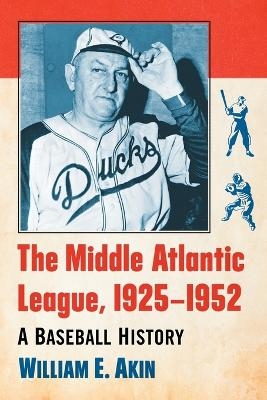
The Middle Atlantic League, 1925-1952
A Baseball History
Seiten
2015
McFarland & Co Inc (Verlag)
978-0-7864-9766-9 (ISBN)
McFarland & Co Inc (Verlag)
978-0-7864-9766-9 (ISBN)
The Middle Atlantic League played from 1925 to 1951 and went through three distinct phases. In the pre-Depression years, communities rallied around the home team, which always stood one step from financial disaster. During the Great Depression, the league flourished as president Elmer Daily magically found investors and night baseball boosted attendance working class.
The small and midsized cities of western Pennsylvania, Ohio and West Virginia reached their peaks of population and prosperity in the second quarter of the 20th century. The baseball teams from these towns formed the Middle Atlantic League, the strongest circuit in the low minors and the one with the most alumni to advance to the majors.
This thorough history chronicles the MAL through three distinct phases from its 1925 inaugural season to its dissolution in 1952. During the first several seasons, most clubs hung one step from financial disaster despite support from local communities. Then the league flourished during the Great Depression as president Elmer Daily magically found investors and night baseball boosted working class attendance. Now enjoying a modicum of financial stability and an infusion of young talent, the clubs became talent farms for major league teams. Both the league and its cities went into decline as the country underwent seismic cultural and economic shifts following World War II.
The small and midsized cities of western Pennsylvania, Ohio and West Virginia reached their peaks of population and prosperity in the second quarter of the 20th century. The baseball teams from these towns formed the Middle Atlantic League, the strongest circuit in the low minors and the one with the most alumni to advance to the majors.
This thorough history chronicles the MAL through three distinct phases from its 1925 inaugural season to its dissolution in 1952. During the first several seasons, most clubs hung one step from financial disaster despite support from local communities. Then the league flourished during the Great Depression as president Elmer Daily magically found investors and night baseball boosted working class attendance. Now enjoying a modicum of financial stability and an infusion of young talent, the clubs became talent farms for major league teams. Both the league and its cities went into decline as the country underwent seismic cultural and economic shifts following World War II.
William E. Akin is a professor emeritus of history from Ursinus College. His articles have appeared in The Historian, American Quarterly and American Historical Review. He lives in Collegeville, Pennsylvania.
Table of Contents
Acknowledgments
Introduction
1. Ghosts, Cokers, Black Diamonds, Milltown Yanks and Stogies: Survival Years, 1925–1929
2. Expanding in the Depression Years: The “Mad-Atlantic League,” 1930–1933
3. A Minor League with Its Own Minor League: Pennsylvania State Association, 1934–1942
4. “Happy Days Are Here Again”: Glory Years, 1934–1939
5. “We intend to keep things going”: War Years, 1940–1945
6. “The muddle gets muddier”: Postwar Years, 1946–1952
Chapter Notes
Bibliography
Index
| Zusatzinfo | 11 photos, 5 maps, notes, bibliography, index |
|---|---|
| Verlagsort | Jefferson, NC |
| Sprache | englisch |
| Maße | 152 x 229 mm |
| Gewicht | 318 g |
| Themenwelt | Sachbuch/Ratgeber ► Sport ► Ballsport |
| Geschichte ► Teilgebiete der Geschichte ► Kulturgeschichte | |
| Weitere Fachgebiete ► Sportwissenschaft | |
| ISBN-10 | 0-7864-9766-1 / 0786497661 |
| ISBN-13 | 978-0-7864-9766-9 / 9780786497669 |
| Zustand | Neuware |
| Haben Sie eine Frage zum Produkt? |
Mehr entdecken
aus dem Bereich
aus dem Bereich
der stille Abschied vom bäuerlichen Leben in Deutschland
Buch | Hardcover (2023)
C.H.Beck (Verlag)
CHF 32,15
vom Mittelalter bis zur Gegenwart
Buch | Softcover (2024)
C.H.Beck (Verlag)
CHF 16,80


